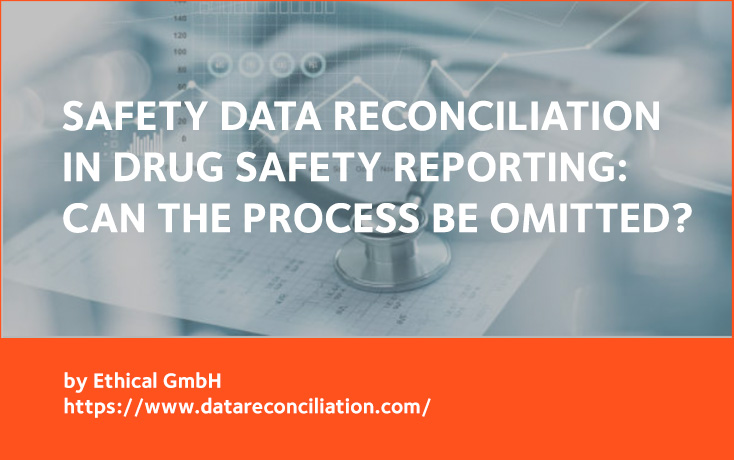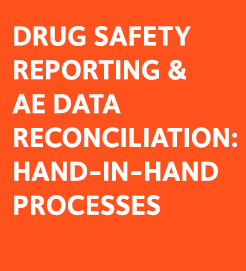Safety data reconciliation is viewed by many as paramount to the quality and reliability of safety data collected during clinical trials, but it requires setting up and using specific tools as well as the regular review and comparison of safety data from different sources. What are the risks of not performing safety data reconciliation while developing new drugs? Is it really necessary to go through complex reconciliation procedures in order to guarantee the quality of the drug safety reporting information? Can’t the safety data collection process suffice to the task? Are there examples supporting one way of doing or another? A deep dive into the drug safety reporting process and related regulations will help find answers to these crucial questions.
What is drug safety reporting exactly?
Evidence based medicine requires efficacy and safety data collected in clinical trials to be of high quality. Complex procedures have been developed over the years to insure required quality level. In particular, safety signals must be monitored all along the development lifecycle in order to avoid exposing participants to unnecessary risk. The detection of safety signals in clinical trials relies heavily on the efficient collection, classification, coding and reporting of Adverse Events (AE) and, most importantly, Serious Adverse Events (SAE) also called “drug safety reporting”. Among those events, some may be known and expected, either because they have already been described for the particular drug in earlier studies or are known to occur with a particular class of drugs. Others are deemed “unexpected” and if such an event is serious and suspected to be due to the drug, then a SUSAR (Serious, Unexpected, Suspected Adverse Reaction) is declared and must be reported within short and very stringent timelines to health authorities.
According to a 2012 FDA guidance on Safety Reporting Requirements1: “The sponsor is required to review promptly all information relevant to the safety of the drug2. During the course of drug development, adverse event information is generally reported to a sponsor by investigators conducting clinical trials; however, a sponsor may become aware of new safety information from a variety of sources, both domestic and foreign. Some examples of sources are listed as follows, but safety information from any other source would also need to be reviewed and evaluated by the sponsor.
• Animal studies or in vitro studies
• Clinical or epidemiological investigations
• Reports in the scientific literature
• Unpublished scientific papers
• Information presented at scientific meetings
• Reports from foreign regulatory authorities
• Reports from commercial marketing experience
• Safety information presented at a professional meeting
• Foreign spontaneous reports
The sponsor’s review should include examining data from all sources and deciding whether the information meets the criteria for expedited reporting, as well as evaluating all accumulating data at regular intervals to update safety information and to identify new safety signals. Some types of information should be sought by the sponsor as part of its continuous pharmacovigilance on the safety of the drug. For example, the sponsor should conduct literature searches regularly with a frequency appropriate to the drug or study design to seek safety information and report that information if necessary.”
How is safety data collected and reported?
During clinical trials, AE and SAE information is often captured using two distinct data capture tools, the Case Report Form (CRF) and the SAE Form, and is recorded in two independent repositories, the clinical database and the pharmacovigilance or safety database. The reasons for the dual process of collecting safety information go back to decades-old operational practices: a clinical leader must ensure that clinical data is as error-free as possible to guarantee the validity of the trial while the medical safety representative is, typically, responsible for the monitoring of emerging safety data from various sources and submission of SUSARs to Competent Authorities and Ethics Committees. Because of this, sponsor companies use different computerized clinical and pharmacovigilance data management systems. The selection of those systems is driven by specific needs. For example, the large volume of Individual Case Safety Report (ICSR) submissions via the E2B case submission process requires very different functionalities from those of an EDC system. As these systems function under different constraints and are often not electronically interfaced, data have to be entered separately in both places.
In the clinical process, the collected clinical data must achieve the highest possible quality before the database lock. Until that time, several verifications including automatic and manual edit-checks are run to compare and verify the data. In case of questions or discrepancies, queries are sent to the sites to collect clarifications and changes are made to the database. However, once locked, no changes are allowed unless the database is reopened (a rather tedious and time-consuming process). SAE data is managed together with all other safety information. In the drug safety reporting (pharmacovigilance) process, information regarding SAEs must be reported by the sites to the sponsor within 24 hours of the investigator's or site’s knowledge, leaving little time for corrections and precision. Furthermore there may be a delay between the initial drug safety reporting of the SAE and the time when information is documented in the clinical database, which can cause inconsistencies in the reported information. In this process, SAE data is primarily prepared for reporting SUSARs to Health Authorities.
Because safety information relative to SAE is captured in these two databases through independent workflows, processing and cleaning of such data is performed twice, which adds to the complexity of SAE management. Making sure that information is matched in these two databases is an additional challenge for clinical research departments, involving multiple teams that can have an impact on data quality, operations performance and compliance. But how necessary is it to perform such reconciliation? Is the drug safety reporting process sufficient and if not why can’t it be improved to cover all the data quality requirements?
Are discrepancies an issue or an opportunity?
The parallel processing of SAEs in two different systems inevitably creates disparities that need to be reconciled at the latest before the clinical database is locked. These disparities may appear at first glance as a weakness but in reality they offer a unique opportunity to cross-check data and correct or enrich it. When reconciliation occurs, verbatim descriptions, coding terms, dates, causality assessment, seriousness criteria and other information can be found to be different. Sometimes whole AEs, relevant medical history or several concomitant medications are missing on one or the other datasets. Some of the discrepancies must be resolved and others have a pre-defined margin of tolerance, but all must be compared, weighted, clarified and, if needed, corrected in either dataset before the clinical database lock. Failure to complete these may result in major or critical findings when inspections are performed by health authorities. For example, in 62 MHRA inspections performed in the drug safety reporting / pharmacovigilance area in 2013, 169 Major and 15 Critical findings were recorded.
How can SAE data reconciliation be done easily?
In summary, safety data reconciliation is not only important but absolutely necessary to the good conduct of clinical trials, and omitting it will fatally lead to serious issues that can jeopardize the marketing authorization. The challenge is therefore to improve the speed and accuracy of such process while minimizing the burden for the different teams involved. A well-thought software for tracking events and discrepancies as well as actions and responsibilities, and that can record all decisions and actions in a compliant audit trail is the optimal solution.
DOWNLOAD NOW THE FREE SAE RECONCILIATION HANDBOOK
The Manual / Reference Book with all the topics related to the Safety Data Reconciliation Management.
______________________________________
1Guidance for Industry and Investigators. Safety Reporting Requirements for INDs and BA/BE Studies. U.S. Department of Health and Human Services. Food and Drug Administration. December 2012
221CFR 312.32(b)







